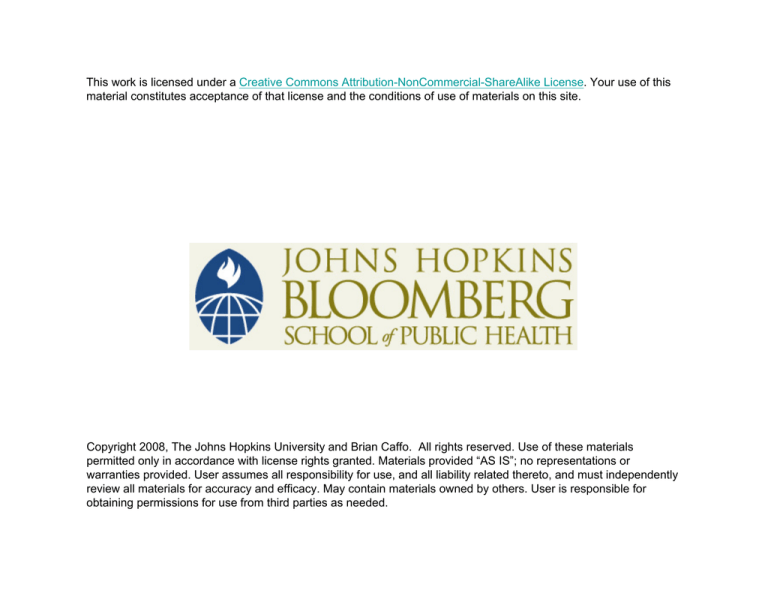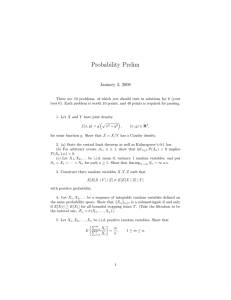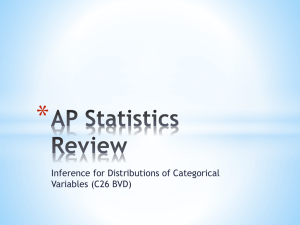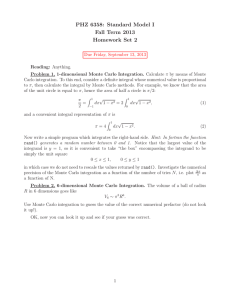
This work is licensed under a Creative Commons Attribution-NonCommercial-ShareAlike License. Your use of this
material constitutes acceptance of that license and the conditions of use of materials on this site.
Copyright 2008, The Johns Hopkins University and Brian Caffo. All rights reserved. Use of these materials
permitted only in accordance with license rights granted. Materials provided “AS IS”; no representations or
warranties provided. User assumes all responsibility for use, and all liability related thereto, and must independently
review all materials for accuracy and efficacy. May contain materials owned by others. User is responsible for
obtaining permissions for use from third parties as needed.
Lecture 22
Brian Caffo
Table of
contents
Outline
Chi-squared
testing
Lecture 22
Testing
independence
Testing
equality of
several
proportions
Generalization
Independence
Brian Caffo
Department of Biostatistics
Johns Hopkins Bloomberg School of Public Health
Johns Hopkins University
Monte Carlo
Goodness of
fit testing
December 19, 2007
Lecture 22
Table of contents
Brian Caffo
Table of
contents
Outline
1 Table of contents
Chi-squared
testing
2 Outline
Testing
independence
3 Chi-squared testing
Testing
equality of
several
proportions
4 Testing independence
Generalization
5 Testing equality of several proportions
Independence
Monte Carlo
6 Generalization
Goodness of
fit testing
7 Independence
8 Monte Carlo
9 Goodness of fit testing
Lecture 22
Brian Caffo
Table of
contents
Outline
Chi-squared
testing
1
Chi-squared tests for equivalence of two binomial
proportions
2
Chi-squared tests for independence, 2 × 2 tables
3
Chi-squared tests for multiple binomial proportions
4
Chi-squared tests for independence, r × c tables
5
Chi-squared tests for goodness of fit
Testing
independence
Testing
equality of
several
proportions
Generalization
Independence
Monte Carlo
Goodness of
fit testing
Lecture 22
Chi-squared testing
Brian Caffo
Table of
contents
Outline
Chi-squared
testing
• An alternative approach to testing equality of proportions
uses the chi-squared statistic
Testing
independence
Testing
equality of
several
proportions
Generalization
Independence
Monte Carlo
Goodness of
fit testing
X (Observed − Expected)2
Expected
• “Observed” are the observed counts
• “Expected” are the expected counts under the null
hypothesis
• The sum is over all four cells
• This statistic follows a Chi-squared distribution with 1 df
• The Chi-squared statistic is exactly the square of the
difference in proportions Score statistic
Lecture 22
Example
Brian Caffo
Table of
contents
Outline
Chi-squared
testing
Testing
independence
Testing
equality of
several
proportions
Trt
X
Y
Side Effects
44
77
121
Generalization
Independence
Monte Carlo
Goodness of
fit testing
• p1 and p2 are the cure rates
• H0 : p1 = p2
None
56
43
99
Total
100
120
220
Lecture 22
Brian Caffo
Table of
contents
Outline
Chi-squared
testing
Testing
independence
Testing
equality of
several
proportions
Generalization
• The χ2 statistic is
P (O−E )2
E
121
• O11 = 44, E11 = 220
× 100 = 55
121
• O21 = 77, E21 = 220 × 120 = 66
99
• O12 = 56, E12 = 220
× 100 = 45
99
• O22 = 43, E22 = 220 × 120 = 54
χ2 =
(44 − 55)2 (77 − 66)2 (56 − 45)2 (43 − 54)2
+
+
+
55
666
45
54
Independence
Monte Carlo
Goodness of
fit testing
Which turns out to be 8.96. Compare to a χ2 with one
degree of freedom (reject for large values).
pchisq(8.96, 1, lower.tail = FALSE)
#result is 0.002
Lecture 22
R code
Brian Caffo
Table of
contents
Outline
Chi-squared
testing
Testing
independence
Testing
equality of
several
proportions
Generalization
Independence
Monte Carlo
Goodness of
fit testing
dat <- matrix(c(44, 77, 56, 43), 2)
chisq.test(dat)
chisq.test(dat, correct = FALSE)
Lecture 22
Notation reminder
Brian Caffo
Table of
contents
Outline
Chi-squared
testing
Testing
independence
Testing
equality of
several
proportions
Generalization
Independence
Monte Carlo
Goodness of
fit testing
n11 = x
n21 = y
n+1
n12 = n1 − x
n22 = n2 − y
n+2
n1 = n1+
n2 = n2+
Lecture 22
Notes
Brian Caffo
Table of
contents
Outline
Chi-squared
testing
Testing
independence
• Reject if the statistic is too large
• Alternative is two sided
• Do not divide α by 2
Testing
equality of
several
proportions
• A small χ2 statistic implies little difference between the
Generalization
• The χ2 statistic and approach generalizes to other kinds of
Independence
Monte Carlo
Goodness of
fit testing
observed values and those expected under H0
tests and larger contingency tables
• Alternative computational form for the χ2 statistic
χ2 =
n(n11 n22 − n12 n21 )2
n+1 n+2 n1+ n2+
Lecture 22
Notes
Brian Caffo
Table of
contents
Outline
• Notice that the statistic:
Chi-squared
testing
χ2 =
Testing
independence
Testing
equality of
several
proportions
Generalization
Independence
Monte Carlo
Goodness of
fit testing
n(n11 n22 − n12 n21 )2
n+1 n+2 n1+ n2+
does not change if you transpose the rows and the
columns of the table
• Surprisingly, the χ2 statistic can be used
•
•
•
•
the rows are fixed (binomial)
the colums are fixed (binomial)
the total sample size is fixed (multinomial)
none are fixed (Poisson)
• For a given set of data, any of these assumptions results in
the same value for the statistic
Lecture 22
Testing independence
Brian Caffo
Table of
contents
Outline
Chi-squared
testing
• Maternal age versus birthweight1
• Cross-sectional sample, only the total sample size is fixed
Testing
independence
Testing
equality of
several
proportions
Mat. Age
< 20y
≥ 20y
Total
Generalization
Independence
Monte Carlo
Goodness of
fit testing
Birthweight
< 2500g ≥ 2, 500g
20
80
30
270
50
350
Total
100
300
400
• H0 : MA is independent of BW
• Ha : MA is not independent of BW
1
From Agresti Categorical Data Analysis second edition
Lecture 22
Continued
Brian Caffo
Table of
contents
Outline
Chi-squared
testing
Testing
independence
Testing
equality of
several
proportions
Generalization
Independence
Monte Carlo
Goodness of
fit testing
• Under H0 (est) P (MA < 20) = 100
400 = .25
50
• Under H0 (est) P (BW < 2500) = 400
= .125
• Under H0 (est)
P (MA < 20 and BW < 2, 500) = .25 × .125
• Therefore
• E11 =
• E12 =
• E21 =
• E22 =
• χ2 =
100
50
400 × 400 × 400 = 12.5
100
350
400 × 400 × 400 = 87.5
300
50
400 × 400 × 400 = 37.5
300
350
400 × 400 × 400 = 262.5
2
(30−37.5)2
(20−12.5)2
+ (80−87.5)
12.5
87.5
37.5
+
(270−262.5)2
262.5
• Compare to critical value
qchisq(.95, 1)=3.84
• Or calculate P-value
pchisq(6.86, 1, lower.tail = F)=.009
= 6.86
Lecture 22
Chi-squared testing cont’d
Brian Caffo
Table of
contents
Outline
Chi-squared
testing
Testing
independence
Group
Clergy
Educators
Executives
Retailers
Total
Testing
equality of
several
proportions
Generalization
Independence
Monte Carlo
Goodness of
fit testing
Alcohol use
High Low
32
268
51
199
67
233
83
267
233
967
Total
300
250
300
350
1,200
2
2
From Agresti’s Categorical Data Analysis second edition
Lecture 22
Brian Caffo
Table of
contents
Outline
Chi-squared
testing
Testing
independence
Testing
equality of
several
proportions
• Interest lies in testing whether or not the proportion of
high alcohol use is the same in the four occupations
• H0 : p1 = p2 = p3 = p4 = p
• Ha : at least two of the pj are unequal
233
• O11 = 32, E11 = 300 × 1200
967
• O12 = 268, E12 = 300 × 1200
Generalization
• ...
Independence
• Chi-squared statistic
Monte Carlo
Goodness of
fit testing
P (0−E )2
E
= 20.59
• df = (Rows − 1)(Columns − 1) = 3
• Pvalue pchisq(20.59, 3, lower.tail = FALSE)≈ 0
Lecture 22
Word distributions
Brian Caffo
Table of
contents
Outline
Chi-squared
testing
Word
a
an
this
that
with
without
Total
Testing
independence
Testing
equality of
several
proportions
Generalization
Independence
Monte Carlo
Goodness of
fit testing
1
147
25
32
94
59
18
375
Book
2
3
186 101
26
11
39
15
105 37
74
28
10
10
440 202
Total
434
62
86
236
161
38
1017
3
3
From Rice Mathematical Statistics and Data Analysis, second edition
Lecture 22
Brian Caffo
Table of
contents
Outline
• H0 : The probabilities of each word
Chi-squared
testing
Testing
independence
Testing
equality of
several
proportions
are the same for every book
• Ha : At least two are different
434
• O11 = 147 E11 = 375 × 1017
434
• O12 = 186 E12 = 440 × 1017
Generalization
• ...
Independence
•
Monte Carlo
• df = (6 − 1)(3 − 1) = 10
Goodness of
fit testing
P (O−E )2
E
= 12.27
Lecture 22
Testing independence
Brian Caffo
Table of
contents
Outline
Chi-squared
testing
Husband
N
F
V
A
Testing
independence
Testing
equality of
several
proportions
Generalization
Independence
Wife’s
N
F
7
7
2
8
1
5
2
8
12 28
Rating
V
A
2
3
3
7
4
9
9
14
18 33
Tot
19
20
19
33
91
Monte Carlo
Goodness of
fit testing
N=never, F=fairly often, V=very often, A=almost
always
4
4
From Agresti’s Categorical Data Analysis second edition
Lecture 22
Independence cont’d
Brian Caffo
Table of
contents
Outline
Chi-squared
testing
Testing
independence
Testing
equality of
several
proportions
Generalization
Independence
Monte Carlo
Goodness of
fit testing
• H0 : H and W ratings are independent
• Ha : not independent
• P(H = N & W = A) = P(H = N)P(W = A)
• stat =
P (O−E )2
E
12
• O11 = 7 E11 = 91 × 19
91 × 91 = 2.51
• Eij = ni+ n+j /n
• df = (Rows − 1)(Cols − 1)
Lecture 22
Independence cont’d
Brian Caffo
Table of
contents
Outline
Chi-squared
testing
Testing
independence
Testing
equality of
several
proportions
x<-matrix(c(7,7,2,3,
2,8,3,7,
1,5,4,9,
2,8,9,14),4)
chisq.test(x)
Generalization
P (O−E )2
Independence
•
Monte Carlo
• df = (4 − 1)(4 − 1) = 9
Goodness of
fit testing
E
= 16.96
• p − value = .049
• Cell counts might be too small to use large sample
approximation
Lecture 22
Notes
Brian Caffo
Table of
contents
Outline
Chi-squared
testing
Testing
independence
Testing
equality of
several
proportions
Generalization
Independence
Monte Carlo
Goodness of
fit testing
• Equal distribution and independence test yield the same
results
• Same test results if
• row totals are fixed
• column totals are fixed
• total ss is fixed
• none are fixed
• Note that this is common in statistics; mathematically
equivalent results are applied in different settings, but
result in different interpretations
Lecture 22
Brian Caffo
Table of
contents
Outline
Chi-squared
testing
Testing
independence
Testing
equality of
several
proportions
Generalization
Independence
Monte Carlo
Goodness of
fit testing
• Chi-squared result requires large cell counts
• df is always (Rows − 1)(Columns − 1)
• Generalizations of Fishers exact test can be used or
continuity corrections can be employed
Lecture 22
Exact permutation test
Brian Caffo
Table of
contents
Outline
Chi-squared
testing
Testing
independence
Testing
equality of
several
proportions
• Reconstruct the individual data
W:NNNNNNNFFFFFFFVVAAANNFFFFFFFF ...
H:NNNNNNNNNNNNNNNNNNNFFFFFFFFFF ...
• Permute either the W or H row
Generalization
• Recalculate the contingency table
Independence
• Calculate the χ2 statistic for each permutation
Monte Carlo
Goodness of
fit testing
• Percentage of times it is larger than the observed value is
an exact P-value
chisq.test(x, simulate.p.value = TRUE)
Lecture 22
Chi-squared goodness of fit
Brian Caffo
Table of
contents
Outline
Chi-squared
testing
Testing
independence
Testing
equality of
several
proportions
Results from R’s RNG
Count
TP
[0, .25)
254
.25
[.25, .5)
235
.25
[.5, .75)
267
.25
[.75, 1)
244
.25
Generalization
Independence
Monte Carlo
Goodness of
fit testing
• H0 : p1 = .25, p2 = .25, p3 = .25, p4 = .25
• Ha : any pi 6= it’s hypothesized value
Total
1000
1
Lecture 22
Continued
Brian Caffo
Table of
contents
Outline
Chi-squared
testing
Testing
independence
Testing
equality of
several
proportions
Generalization
• O1 = 254 E1 = 1000 × .25 = 250
• O2 = 235 E2 = 1000 × .25 = 250
• O3 = 267 E3 = 1000 × .25 = 250
• O4 = 244 E4 = 1000 × .25 = 250
P (O−E )2
Independence
•
Monte Carlo
• df = 3
Goodness of
fit testing
• P − value = .52
E
= 2.264
Lecture 22
Testing Mendel’s hypothesis
Brian Caffo
Table of
contents
Outline
Chi-squared
testing
Testing
independence
Testing
equality of
several
proportions
Observed
TP
Expected
Generalization
Phenotype
Yellow
Green
6022
2001
.75
.25
6017.25 2005.75
Total
8023
1
8023
Independence
Monte Carlo
Goodness of
fit testing
• H0 : p1 = .75, p2 = .25
•
P (0−E )2
E
=
(6022−6017.25)2
6017.25
+
(2001−2005.75)2
2005.75
= .015
Lecture 22
Continued
Brian Caffo
Table of
contents
Outline
Chi-squared
testing
Testing
independence
• df = 1
Testing
equality of
several
proportions
• P-value = .90
Generalization
Independence
Monte Carlo
Goodness of
fit testing
• Fisher combined several of Mendel’s tables
•
P
χ2vi ∼ χ2P vi
• Statistic 42, df = 84, P-value = .99996
• Agreement with theoretical counts is perhaps too good?
Lecture 22
Notes on GOF
Brian Caffo
Table of
contents
Outline
Chi-squared
testing
Testing
independence
Testing
equality of
several
proportions
• Test of whether or not observed counts equal theoretical
values
• Test statistic is
P (0−E )2
E
• TS follows χ2 distribution for large n
Generalization
• df is the number of cells minus 1
Independence
• Undirected alternative is problematic
Monte Carlo
Goodness of
fit testing
• Especially useful for testing RNGs
• Kolmogorov/Smirnov test is an alternative test that does
not require discretization but often has low power








